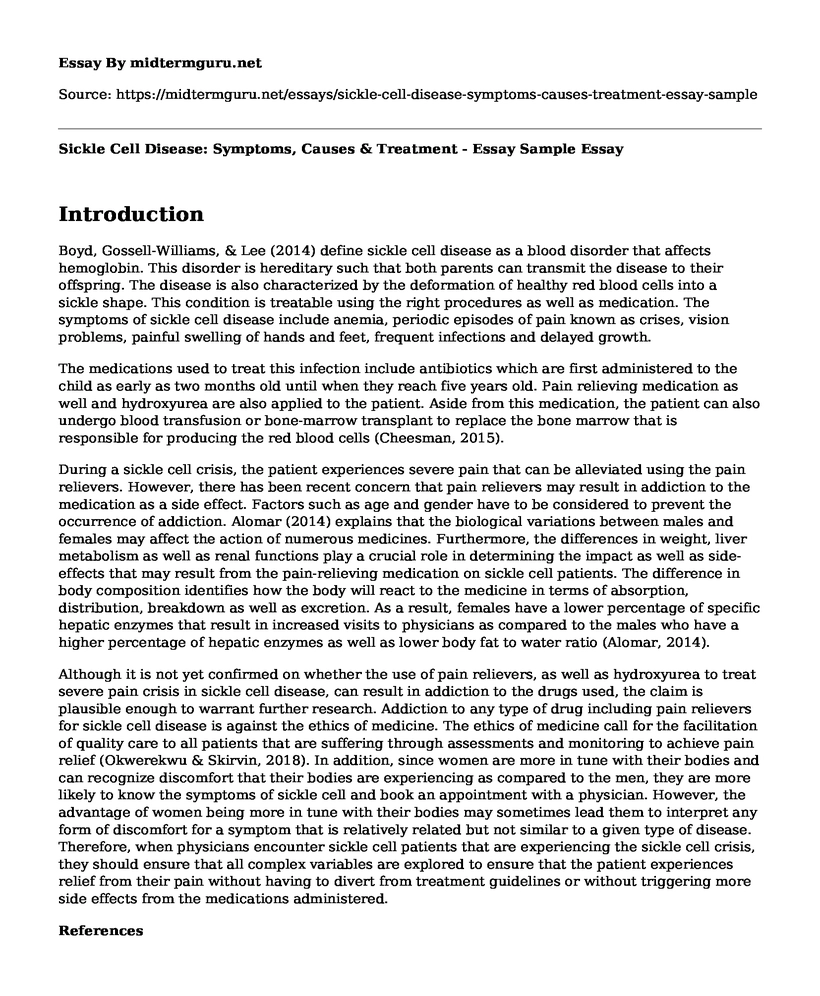Introduction
Boyd, Gossell-Williams, & Lee (2014) define sickle cell disease as a blood disorder that affects hemoglobin. This disorder is hereditary such that both parents can transmit the disease to their offspring. The disease is also characterized by the deformation of healthy red blood cells into a sickle shape. This condition is treatable using the right procedures as well as medication. The symptoms of sickle cell disease include anemia, periodic episodes of pain known as crises, vision problems, painful swelling of hands and feet, frequent infections and delayed growth.
The medications used to treat this infection include antibiotics which are first administered to the child as early as two months old until when they reach five years old. Pain relieving medication as well and hydroxyurea are also applied to the patient. Aside from this medication, the patient can also undergo blood transfusion or bone-marrow transplant to replace the bone marrow that is responsible for producing the red blood cells (Cheesman, 2015).
During a sickle cell crisis, the patient experiences severe pain that can be alleviated using the pain relievers. However, there has been recent concern that pain relievers may result in addiction to the medication as a side effect. Factors such as age and gender have to be considered to prevent the occurrence of addiction. Alomar (2014) explains that the biological variations between males and females may affect the action of numerous medicines. Furthermore, the differences in weight, liver metabolism as well as renal functions play a crucial role in determining the impact as well as side-effects that may result from the pain-relieving medication on sickle cell patients. The difference in body composition identifies how the body will react to the medicine in terms of absorption, distribution, breakdown as well as excretion. As a result, females have a lower percentage of specific hepatic enzymes that result in increased visits to physicians as compared to the males who have a higher percentage of hepatic enzymes as well as lower body fat to water ratio (Alomar, 2014).
Although it is not yet confirmed on whether the use of pain relievers, as well as hydroxyurea to treat severe pain crisis in sickle cell disease, can result in addiction to the drugs used, the claim is plausible enough to warrant further research. Addiction to any type of drug including pain relievers for sickle cell disease is against the ethics of medicine. The ethics of medicine call for the facilitation of quality care to all patients that are suffering through assessments and monitoring to achieve pain relief (Okwerekwu & Skirvin, 2018). In addition, since women are more in tune with their bodies and can recognize discomfort that their bodies are experiencing as compared to the men, they are more likely to know the symptoms of sickle cell and book an appointment with a physician. However, the advantage of women being more in tune with their bodies may sometimes lead them to interpret any form of discomfort for a symptom that is relatively related but not similar to a given type of disease. Therefore, when physicians encounter sickle cell patients that are experiencing the sickle cell crisis, they should ensure that all complex variables are explored to ensure that the patient experiences relief from their pain without having to divert from treatment guidelines or without triggering more side effects from the medications administered.
References
Alomar, M. J. (2014). Factors affecting the development of adverse drug reactions (Review article). Saudi Pharmaceutical Journal, 22(2), 83-94. Doi:10.1016/j.jsps.2013.02.003
Boyd, I., Gossell-Williams, M., & Lee, M. (2014). The Use of Analgesic Drugs in Patients with Sickle Cell Painful Crisis. West Indian Medical Journal. doi:10.7727/wimj.2012.272
Cheesman, S. (2015). Sickle cell disease: symptoms, complications, and management. Clinical Pharmacist. doi:10.1211/cp.2015.20069268
Okwerekwu, I., & Skirvin, J. A. (2018). Sickle Cell Disease Pain Management. US Pharmacist, 43(3), 12-18. Retrieved from https://www.uspharmacist.com/article/sickle-cell-disease-pain-management
Cite this page
Sickle Cell Disease: Symptoms, Causes & Treatment - Essay Sample. (2022, Dec 27). Retrieved from https://midtermguru.com/essays/sickle-cell-disease-symptoms-causes-treatment-essay-sample
If you are the original author of this essay and no longer wish to have it published on the midtermguru.com website, please click below to request its removal:
- Servant Leadership in Nursing Team
- Roles of a Community Health Worker - Paper Example
- Differences Between a Healthy and an Unhealthy Brain - Essay Example
- Air Pollution in the World and Its Effects - Essay Example
- Paper Example on Fat and Protein Consumption
- Rising Prescription Drug Prices: A Major Issue and Call for Action - Essay Sample
- Nurse as Patient Advocate: Protecting Rights & Supporting Decisions - Essay Sample







